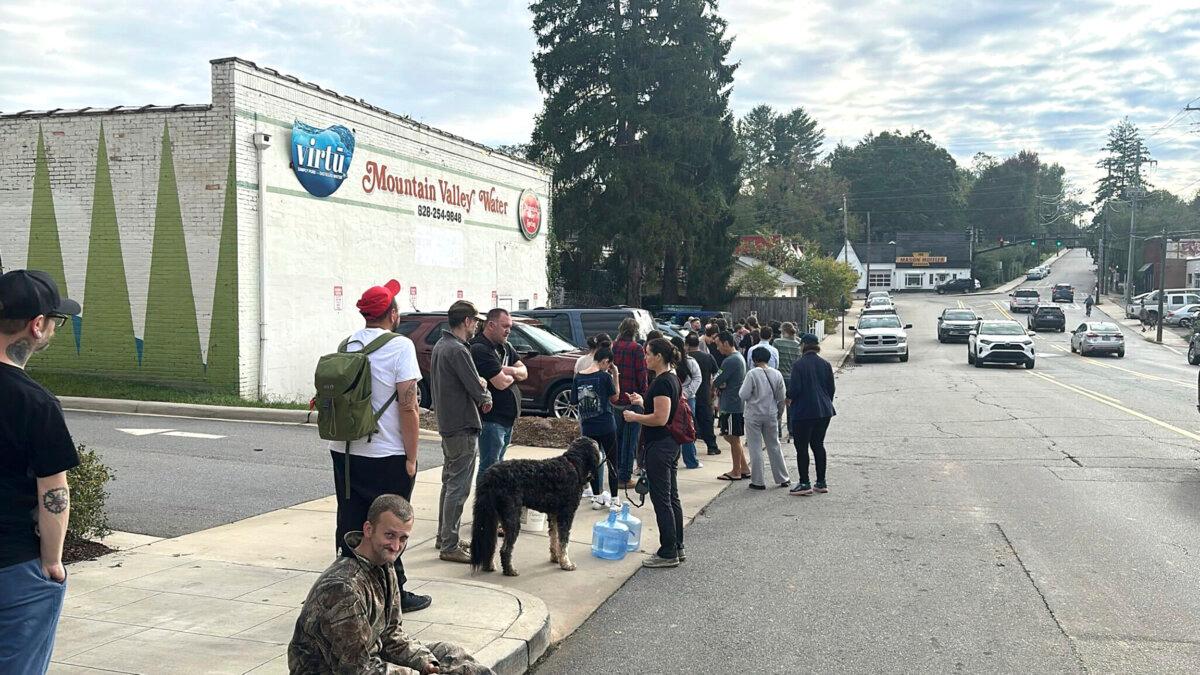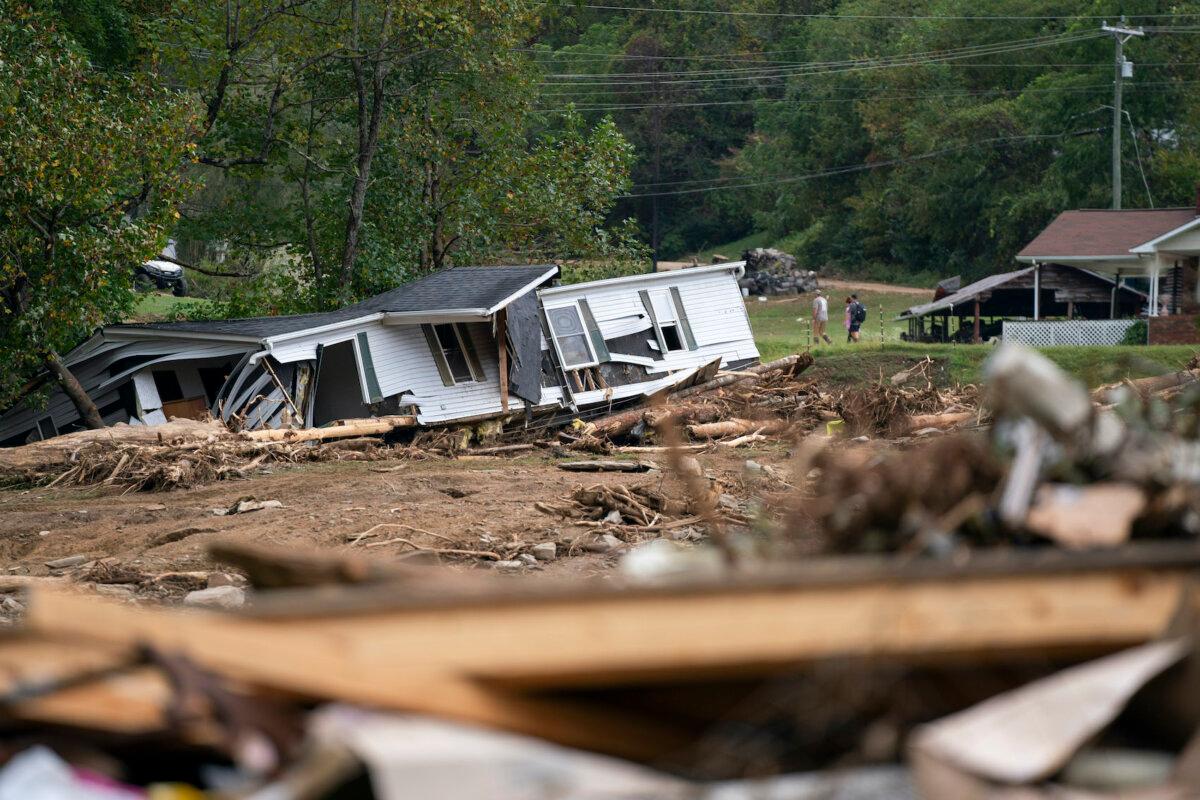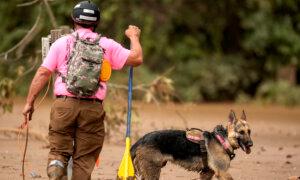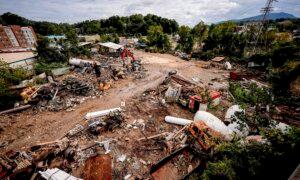For Asheville-area party committees, the only campaigns that matter now are those to find missing friends, displaced family, and a reconnection with the world.
A long slog of canvassing, caucusing, and consolidating was to a conclude in a hectic five-week sprint to Election Day.
It was all planned: Rallies, stumps, speeches, caravans. Candidates for local offices, state legislature, governor, Congress, the presidency—yes, even the presidency—were slated for meet-and-greets because North Carolina is among seven “battleground” states pundits say will determine who sits in the Oval Office in 2025.
In four Swannanoa Valley counties—Buncombe, Henderson, Hayward, Madison—clustered around Asheville in western North Carolina, the Blue Ridge was electric in election friction between the growing city’s Democratic base and the deep red small towns ringing it—critical constituencies in any statewide race.
The county committees that field the foot soldiers for state parties and national candidates, that drive turnout, boost enthusiasm, do the door-knocking and phone-polling, were primed, ready for the final push.
None of that matters now.
Not since Sept. 27–28 when Asheville and nearby towns were flattened by mountains of water and buried under mountains of mud and debris after a three-day deluge funneled three months of rain into the valleys that tumble from the Land of the Sky onto the Piedmont Plateau.
The only campaigns that matter now are those to find missing friends, displaced family members, and a reconnection with the world beyond their suddenly, savagely reshaped landscape.
“Politics can wait for a couple of weeks,” Madison County Republican Party Chair Patrick Ward said while “playing emergency manager” at the Marshall Fire Department, where he is a firefighter.
“I’ve been working since 3:30 Friday morning,” Ward told The Epoch Times four days later, noting he’d not heard from many GOP county board members because most don’t have power, phone service, or water.
Henderson County Democratic Party volunteer Joanne Dufilh was answering the committee’s phone, relaying messages to Chair Leslie Carey, who’d been forced from her flooded home.
“Oh my gosh,” Dufilh said, “we’re not really thinking about meets-and-greets now. Everything—it’s a jigsaw puzzle. It’s really unexpected because we’re in the mountains. We don’t usually get a lot of hurricane damage.”
Buncombe County Democratic Party County Chair Kathie Kline had just received word on Sept. 30 that at least 40 local residents were feared dead in Helene’s wake.
“Things are pretty devastated right now,” Kline told The Epoch Times. “We are very saddened by the news and very concerned and not thinking about the political landscape at this point when there are 80,000 to 90,000 people without water and without power” in western North Carolina.

Homes and vehicles damaged in a flash flood from Hurricane Helene lie on the side of a road near the Swannanoa River in Swannanoa, N.C. Oct. 1, 2024. Mike Stewart/AP Photo
Henderson County Republican Chair Brett Callaway had just heard from his daughter. That was good news, but her news was bad. Her “business 20 minutes from where I am sitting was entirely washed away” in Chimney Rock, Callaway said.
“Where it sat is now in the new channel for the river,” he told The Epoch Times on Sept. 30. “That little town was completely wiped out,” and there is no way to get there because all roads and bridges are gone.
The local committee is “unable to organize much yet, but the state has been very good. The state GOP, they are ready,” Callaway said, noting state Chair Jason Simmons “reached out to me personally to find out how we’re doing.”
In an Oct. 1 statement emailed to The Epoch Times, Simmons said the “severe damage and heartbreaking images we see in western North Carolina are sobering,” and the Raleigh-based state staff is communicating with all county chairs.
“Yet, the reality is, we are now 35 days away from Nov. 5, and we’re going to deliver a third time for President Trump,” he said. “For months, we have encouraged voters to make a plan to vote. We will utilize every resource to ensure voters have that capability.”
‘Countrypolitan Counties’
As defined by Duke University Sanford School of Public Policy Professor Mac McCorke and Rachel Salzburg in their 2022 paper, North Carolina’s 100 counties can be grouped into five distinct constituencies.
They are: 10 “bigger city” metropolitan counties—Wake where Raleigh is, Mecklenburg where Charlotte is, New Hanover where Wilmington is, and Buncombe where Asheville is; 12 “smaller city” metro counties; 25 “micropolitan” counties; 25 “thoroughly rural” counties; and 28 “countrypolitan” counties.
Those 28 “countrypolitan” counties ring Democrat-dominated “bigger city” metropolitan counties and generally vote Republican. In 2020, President Donald Trump won 25 of these “countrypolitan counties,” including 20 by more than 20 percentage points.
The counties are clustered within seven metropolitan statistical areas (MSAs) across North Carolina; three “countrypolitan” counties in the Asheville MSA—Henderson, Haywood, Madison—and Buncombe are among the 25 western North Carolina counties declared disaster zones.
While Wake and New Hanover counties are the most-watched trench-fight counties in the battleground state, the “countrypolitan” counties are collectively critical to GOP aspirants. Republican voters must turn out in overwhelming numbers in these counties to win state elections.
For Democrats, Asheville-anchored Buncombe Comity is a blue dot in a red sea, a vital outpost of viability.
Henderson County, where Trump defeated President Joe Biden by nearly 19 percent in 2020, is a brick in a red wall of thinly populated counties that collectively blunt Buncombe County, which voted for Biden also by a 19-percentage point spread.
“Henderson is actually key” in winning any North Carolina election, Callaway said. “Look at it this way, you cannot win a statewide election unless you win western North Carolina and you cannot win western North Carolina unless you win Henderson County.”
While the election is at the moment not a pressing priority, the county chair admitted it was on his mind.
“I think by the time the election comes, things will be figured out. Absentee ballots, they’re being sent out now. Early in-person voting begins Oct. 17, so there is some time,” Callaway said.
By then, many busted roads will be passable and it’s not likely polling places will change, he mused, although “you may have to take a circuitous route” to get to them.
The disaster “will not dampen turnout,” Callaway said, before adding “probably, somewhat.”

People wait to gather water at Mountain Valley Water in the aftermath of Hurricane Helene in West Asheville, N.C., on Sept. 30, 2024. Jeffrey Collins/AP Photo
North Carolina State University Political Science Professor Steven Greene told The Epoch Times in a Sept. 30 email much focus has been on Asheville, which is likely to recover relatively quickly.
That may not be true for the “very red counties that, in many cases, have been devastated even worse and will recover more slowly than Asheville,” Greene said.
Catawba University Politics Department Chair Michael Bitzer, author of “Redistricting and Gerrymandering in North Carolina: Battlelines in the Tar Heel State,” said the disaster will have a “larger impact on election administration—the basic infrastructure, if they can get poll workers, and if voters will be able to cast a ballot. All of those things, we don’t know right now.”
Hurricane Matthew in 2016 hit eastern North Carolina hard, resulting in “for the counties affected, a slight turnout depression but nothing significant,” Bitzer said.
But Matthew left nothing like the wreckage in Helene’s wake. “Is turnout going to be depressed or will [state elections officials approve] options for greater convenience? I don’t know,” Bitzer said.
A campaign consultant since 1991 who has orchestrated more than 400 campaigns across the state, Crone told The Epoch Times that “stressful” times await local election boards that “have to regroup and make changes in their plans in how to execute the election.”
The only comparative circumstances he could cite were 1996’s Hurricane Fran and 1999’s Hurricane Floyd, but both were at least 60 days before elections and only affected coastal areas.
Campaigns will need to change tactics in devastated areas, Crone said. “You’re going to have problems getting mail delivered for the next week, the next two weeks,” he said.
Party volunteers will need to track down people “who have lost homes” to ensure they get to the polls, Crone said, and advertising will need to “shift over to broadcast TV.”
“You won’t see robust door-to-door [canvassing] either,” he said. “The campaigns will back off and allow the space and time that victims need to pull everything back together.”
But in the end, Crone predicted, voters are going to vote.
“I believe the voters of western North Carolina will be engaged and will turn out,” he said. “It may not be 70 percent like we’ve seen in past elections, but they understand what is on the line.”

A destroyed home in the aftermath of Hurricane Helene near Black Mountain, N.C., on Sept. 30, 2024. Sean Rayford/Getty Images
‘One Family Strong’
But first things first, county party officials said. Once they regain footing in the coming days, the same energy that galvanizes political campaigns will be dedicated to helping neighbors.
Dufilh said Henderson County’s Democrats were already putting together a plan. They’d be stacking bottled water and foods at their Hendersonville headquarters on Oct. 2 and on Oct. 5, “we’ll be grilling hot dogs” in the parking lot.
That was the best she could do “planning on the fly,” Dufilh said, noting there’s already “an amazing list of businesses wanting to help” providing everything from plastic tarps to pet food.
“People are really pulling together. Everybody who has things, whatever people have to offer, they’re reaching out. Amazing,” Dufilh said.
Buncombe County Democrats are also joining nonprofits to help heal their neighborhoods, Kline said.
“I will say our perspective is providing response and services to all of our residents regardless of our political differences,” she said.
“We got to get everything cobbled together first” before resuming partisan campaign activities, Madison County GOP chair Ward said from the Marshall Fire Department.
“Right now,” he said, “we’re one family strong—all of us.”
Original News Source Link – Epoch Times
Running For Office? Conservative Campaign Consulting – Election Day Strategies!


